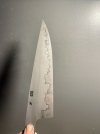Good morning fellow knife nuts, this is my first post, and I want to start off by saying that this forum is an awesome resource for makers, new and old
I've been lurking here, absorbing knowledge while I make knives, and I truly can't thank all of you enough. My question is: do you need to soak a clay coated 1095 blade at temp (per Larrin's formula), or just go to non magnetic, then quench? Will soaking (for 10 min?) reduce hamon activity? It would seem that long at temp would leave a blade through heated. Any guidance would be greatly appreciated, thanks in advance.
I've been lurking here, absorbing knowledge while I make knives, and I truly can't thank all of you enough. My question is: do you need to soak a clay coated 1095 blade at temp (per Larrin's formula), or just go to non magnetic, then quench? Will soaking (for 10 min?) reduce hamon activity? It would seem that long at temp would leave a blade through heated. Any guidance would be greatly appreciated, thanks in advance.









